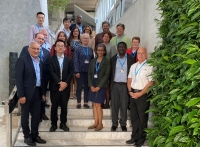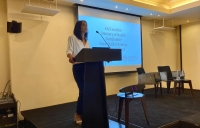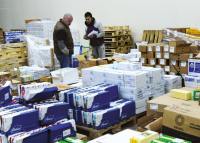News

03/10/2022
The Food and Agriculture Organization of the United Nations (FAO) and Danone have been collaborating to improve global nutrition and food safety knowledge and promote sustainable food systems since 2019 under a Memorandum of Understanding (MOU).
In this context, FAO and Danone set out to review the current trends and drivers linked to the emergence of new food allergens and reflect on future perspectives for this area. These findings are shared in the joint review, Are alternative proteins increasing food allergies? Trends, drivers and future perspectives, recently published in the journal, Trends in Food Science & Technology.
“As we search...

03/10/2022
As part of an FAO project to defeat foodborne antimicrobial resistance (AMR), the first of a series of webinars in the Latin American and Caribbean region was held on 14-15 September 2022. The nearly 500 participants learned about the use of Codex Alimentarius texts, the impact they can have when it comes to keeping food safe from antimicrobial resistant organisms and residues. The webinar was called: “Guide and orientation for new Codex Alimentarius participants“. The second webinar “Basic Codex texts“ will be held on 7 December 2022 at 10:00 - 12:00 (GMT-5) in Spanish and English and the series...

30/09/2022
FAO and WHO released a report today that reviews the food safety information currently available about seaweed harvested from both wild stocks and aquaculture and recommends further discussion as well as international guidance. The document reports that morbidities and mortalities linked to the consumption of seaweeds are rare, but cautions that the limited data raise concerns that certain hazards may be present in seaweed. These include: chemical hazards such as heavy metals (principally inorganic arsenic and cadmium), persistent organic pollutants (e.g. dioxins and polychlorinated biphenyls), radionuclides and pesticide residues; microbiological hazards (e.g. Salmonella spp., Bacillus spp., and norovirus); physical hazards...

14/09/2022
This week in Geneva, Switzerland, the Joint Expert Meeting on Microbiological Risk Assessment (JEMRA) is holding an in-person expert meeting to discuss interventions to control Salmonella in poultry and poultry meat. The secretariat is happy to host international experts from all six FAO regions; Africa, Asia Pacific, Europe and Central Asia, Latin America, Near East and North America.
The meeting is in response to a request from Codex Alimentarius, as they are looking to update guidance and best practices for poultry as salmonellosis continues to be a significant public health concern. Although the JEMRA has addressed Salmonella in poultry in the...

09/09/2022
Participants of a meeting that was co-hosted by FAO in Tel Aviv, Israel on 7 September 2022 visited a production facility that is in the process of developing cell-based food in nearby Rehovot. Following the session called ‘FAO and the Israeli Ministry of Health stakeholder roundtable meeting on cell-based food and the future of food security and food safety’, the 34 participants were able to see first-hand the technologies and techniques they had spoken about the day before.
The international group saw a real-life example of the cell-based food production process as well as advanced equipment. As CEO,...

07/09/2022
FAO and the Ministry of Health of Israel hosted a meeting on 7 September 2022 in Tel Aviv, Israel, where a group of researchers and developers gathered to discuss cell-based food. Speakers from different parts of the world focused on the products they are working on, how safety is (or will be) assured and their potential benefits to food security.
Speaking on behalf of Sharon Alroy-Preis, Head of Public Health Services, and Pnina Oren-Shneidor, Director of the National Food Service, both with the Ministry of Health of Israel, Ziva Hamama, Head of Food Risk Management Department welcomed the 43 participants, highlighting...

18/08/2022
Antimicrobial stewardship (AMS), a challenging concept, not always clear for many stakeholders, is the focus of a recent open-access peer-reviewed publication. The paper was authored by a multi disciplinary team of FAO colleagues and published in a special issue of the scientific journal, Microorganisms, by MDPI.
With it, the reader can get acquainted with several of the work streams and initiatives that FAO is involved in, including: awareness raising, behaviour change, governance (at the global and local levels), good practices, implementation of AMR-related Codex standards and surveillance. In addition to diagnostic instruments such as the Assessment Tool for Laboratories...

08/08/2022
FAO has issued a new guidance document that explains how to design and implement a food control e-notification system according to a country’s needs and resources. The document, called Technical guidance for the implementation of e-notification systems for food control, walks readers through using e-notification data as a supporting instrument to improved import controls.
More than a third of agrifood exports cross borders at least twice before reaching the final consumer, creating new and greater challenges for the management of food safety as tracing the origin is more complex and time-consuming.
“As countries transition toward digitalization of food control systems, this...

01/07/2022
Upon detection of the Group B Streptococcus (GBS) in freshwater fish in several countries in Asia, FAO published a risk profile to raise awareness about the threat.
Masami Takeuchi, FAO Food Safety Officer, said many people aren’t aware of the risks associated with consuming raw freshwater fish, which is very common in Southeast Asia. “But the disease this practice can cause can be serious, though not always obvious, nor immediate, and in some cases that can make it difficult to diagnose and treat in time,” Takeuchi said.
Outside of Singapore where the first large-scale outbreak from consumption of raw...

28/06/2022
For good reason people want to know about imminent threats in advance – to get prepared to face and effectively manage them. In food safety, under the risk analysis umbrella, anticipation is possible through a combination of long-term, medium-term and short-term approaches, that include among others foresight which looks into drivers, analysis of scenarios and risk trends, risk assessment, early warning and rapid alert systems. Food safety early warning refers to a time spanning from the present for up to one year. Evidence screening and analysis is part of the early warning operations.
To better ensure the availability of safe food...
Stay up to date and connect to our RSS feed!
